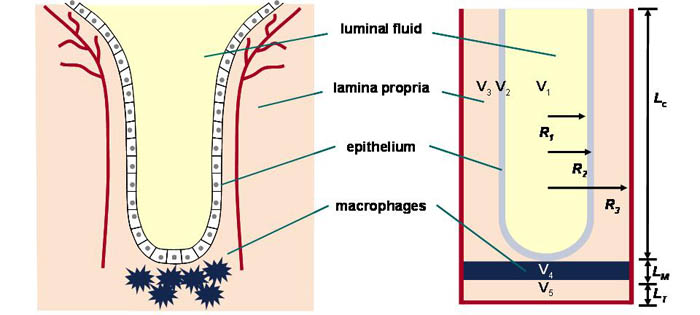
Department of Chemical Engineering
Room 66-453
Massachusetts Institute of Technology
77 Massachusetts
Avenue
Cambridge, MA 02139-4307 USA
Telephone 617 253-6483
Email: mpchin@mit.edu

Melanie Chin
Graduate Research Assistant
B.S., Chemical Engineering, North Carolina State University, 2004
B.A., Chemistry, North Carolina State University, 2004
Research Interests
Reaction and Diffusion of Nitric Oxide in the Colon During Inflamation
Nitric oxide is used in the body's immune response to kill off invading organisms. However, under prolonged exposure to high concentrations of NO, as seen with chronic infection and inflammation, NO exhibits cytotoxic characteristics and causes damage to the host tissue. Epidemiological studies demonstrate an association between chronic inflammation and increased cancer risk. For example, inflammatory bowel diseases (IBDs), cause inflammation of the small and large intestines and can be precursors to colon cancer. Although the precise etiology and pathogenesis of IBDs remain unclear, there is a growing body of both experimental and clinical evidence which links chronic gut inflammation with enhanced production of NO.
Colonic biopsies taken from patients with active ulcerative colitis have increased expression of inducible nitric oxide synthase (iNOS), which is the enzyme that catalyzes the formation of NO. IBD animal models developed by our collaborators also demonstrate enhanced iNOS activity in inflamed colonic mucosa. My research attempts to link what we observe in these IBD-afflicted colons with our group's existing knowledge in NO chemistry and kinetic rates. Specifically, from immunohistochemical stains, it seems that both macrophages and epithelial cells could be potential sources for NO in the inflamed mucosa, but the relative contributions of the different cell types is unknown. Moreover, even though these images show increased expression of iNOS, the actual concentration of NO present in these systems remains unknown. Thus, I will focus on characterizing cellular NO and O2 synthesis and consumption rates for macrophages and epithelial cells. These kinetic rates will be incorporated into a model which predicts the concentrations of NO in intestinal crypts, and will hopefully give us a better understanding of how NO affects the development of inflammatory bowel diseases.
Personal Interests
My personal interest in this area stemmed from the desire to work on a project where the broader scope was apparent. In this project, we work closely with other collaborators in biological engineering and comparative medicine. Not only does this enable a greater exchange of ideas, but we are also able to see our work applied directly in other areas of research. Outside of research, I swim and train with the MIT Masters Swim Club. Other things I enjoy: scuba diving (whenever possible), traveling, sudoku and crossword puzzles, and watching movies (my record is five in one day). To fill the void of being separated from my beloved cocker spaniel, Speedo, who still resides in NC, I volunteer regularly with the MSPCA.
